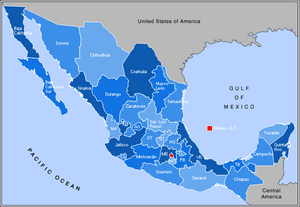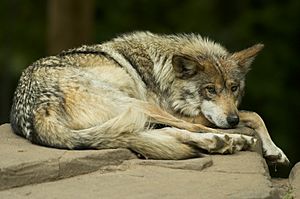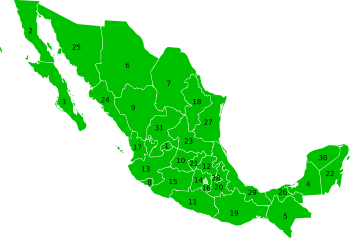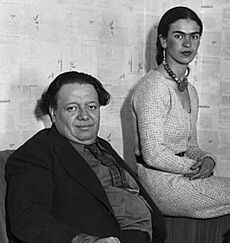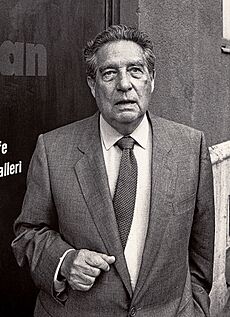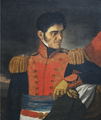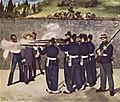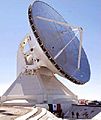Mexico facts for kids
Quick facts for kids
United Mexican States
Estados Unidos Mexicanos (Spanish)
|
|
|---|---|
|
Anthem:
Himno Nacional Mexicano |
|
| Capital and largest city
|
Mexico City 19°26′N 99°8′W / 19.433°N 99.133°W |
| Official languages | Spanish (de facto) |
| Co-official languages |
|
| Ethnic groups | See below |
| Religion
(2020)
|
|
| Demonym(s) | Mexican |
| Government | Federal presidential republic |
| Claudia Sheinbaum | |
| Gerardo Fernández Noroña | |
| Sergio Gutiérrez Luna | |
| Legislature | Congress |
| Senate | |
| Chamber of Deputies | |
| Independence
from Spain
|
|
| 16 September 1810 | |
|
• Declared
|
27 September 1821 |
| 28 December 1836 | |
|
• First constitution
|
4 October 1824 |
|
• Second constitution
|
5 February 1857 |
| 5 February 1917 | |
| Area | |
|
• Total
|
1,972,550 km2 (761,610 sq mi) (13th) |
|
• Water (%)
|
1.58 (as of 2015) |
| Population | |
|
• 2023 estimate
|
|
|
• Density
|
61/km2 (158.0/sq mi) (142nd) |
| GDP (PPP) | 2024 estimate |
|
• Total
|
|
|
• Per capita
|
|
| GDP (nominal) | 2024 estimate |
|
• Total
|
|
|
• Per capita
|
|
| Gini (2022) | ▼ 40.2 medium |
| HDI (2023) | high · 77th |
| Currency | Mexican peso (MXN) |
| Time zone | UTC−8 to −5 (See Time in Mexico) |
|
• Summer (DST)
|
UTC−7 to −5 (varies) |
| Date format | dd/mm/yyyy |
| Driving side | right |
| Calling code | +52 |
| ISO 3166 code | MX |
| Internet TLD | .mx |
|
|
Mexico (Spanish: México, official name: United Mexican States (Spanish: Estados Unidos Mexicanos, ) is a country in North America. Mexico is south of Texas and other American states. Guatemala and Belize are south of Mexico. Mexico is between the Pacific Ocean and the Gulf of Mexico.
People living in Mexico or who are from there are called Mexicans. Most Mexican people speak Spanish. There are also Mexicans who speak Native American languages, like Nahuatl, Maya, and Zapotec. The capital of Mexico is Mexico City.
Contents
Etymology
Mēxihco is the Nahuatl term for the heartland of the Aztec Empire, namely the Valley of Mexico and surrounding territories, with its people being known as the Mexica.
History
Before the Europeans came, many Native American cultures existed in Mexico. The earliest was the Olmec culture in the south. The Olmecs are famous for the large stone heads they made. On the Yucatán peninsula lived the Mayans. The Mayans lived in city states ruled by kings. The Mayans were most powerful between 200 and 900 A.D. Another powerful empire belonged to Teotihuacan. Teotihuacan was a very large city, one of the largest at that time. After Teotihuacan declined the Toltecs became powerful. Things made by the Toltecs have been found from the southern parts of the U.S. all the way to Costa Rica. A famous Toltec god is Quetzalcoatl. The Toltec culture declined too, and it was succeeded by the Aztecs. The Aztecs called their own empire Mexico. A famous Aztec king was Moctezuma II.
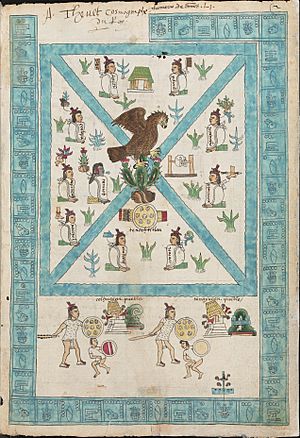
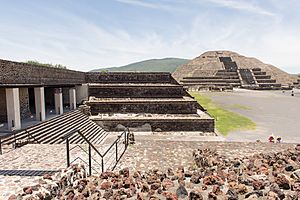
In 1519 the Spanish explorer Hernán Cortés came to Mexico. The Aztecs thought he was the returned Quetzalcoatl, so they did not want to fight against him. Cortes allied himself with the enemies of the Aztecs. In 1521 they conquered the Aztec capital Tenochtitlan. The Aztec Empire became part of Spain. It was called New Spain.
In 1810 the Mexican priest Miguel Hidalgo started the Mexican war of independence. In 1821 the Spanish finally retreated and Mexico became independent. The first leader of independent Mexico was Agustin de Iturbide. He set up the First Mexican Empire and became emperor. But the Mexicans were not happy with him, and in 1823 the country became a republic.
A man who was very important in Mexico in the early 19th century was Antonio López de Santa Anna. He was the president of Mexico 11 times. When he became a dictator, Texas declared independence (1836). The Battle of the Alamo was part of this Texas Revolution. Between 1846 and 1848 there was war between Mexico and the United States. In this war Mexico lost its large northern areas, which became the southwestern United States. After this war Santa Anna was sent away to Venezuela.
Between 1858 and 1861 there was war again, between liberals and conservatives. The liberal Benito Juárez won the war and became president afterwards. Juarez stayed president until France invaded Mexico and made Maximilian of Habsburg emperor of the Second Mexican Empire. But Maximilian was very unpopular. After more war he was executed in 1867, and Juarez became president again.
Conservatives thought Juarez had too much power. In 1876 they ousted him, and made Porfirio Díaz, a general who had won a battle against the French, president. Porfirio Díaz made the country wealthier, but the poor people became poorer. Franciso I. Madero started the Mexican Revolution in 1910.
The next 10 years the country was in chaos. There were many presidents who ruled for a short time and all kinds of people fought against each other. Famous people from this period are Emiliano Zapata, Pancho Villa and Francisco I. Madero. When Álvaro Obregón became president in 1920 the fighting calmed down.
In 1929 President Plutarco Elías Calles founded the National Mexican Party, PNM. The party was later renamed Institutional Revolutionary Party, PRI. The party would rule for a very long time. Most PRI presidents were not popular, it was said that they were only president to become richer themselves. An exception was president Lázaro Cárdenas. He was president between 1934 and 1940.
After several decades more and more people became unhappy with the PRI. In 1968 security forces shot at protesters, this caused several hundred deaths and became known as the Tlatelolco massacre. Another uprising was in 1994 when Zapatistas rebelled in the province Chiapas.
Mainly through ballot box fraud the PRI managed to stay into power until 2000, when Vicente Fox of the National Action Party, PAN, was elected president. In total the PRI had governed Mexico for 71 years.
Claudia Sheinbaum, López Obrador's political successor, won the 2024 presidential election in a landslide and upon taking office in October became the first woman to lead the country in Mexico's history. She was sworn in as Mexico's president on 1 October 2024.
Geography
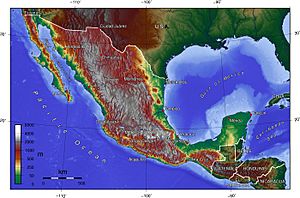

Mexico is located between latitudes 14° and 33°N, and longitudes 86° and 119°W in the southern portion of North America, with a total area of 1,972,550 km2 (761,606 sq mi), is the world's 13th largest country by total area. It has coastlines on the Pacific Ocean and Gulf of California, as well as the Gulf of Mexico and Caribbean Sea, the latter two forming part of the Atlantic Ocean. Within these seas are about 6,000 km2 (2,317 sq mi) of islands (including the remote Pacific Guadalupe Island and the Revillagigedo Islands). Almost all of Mexico lies in the North American Plate, with small parts of the Baja California peninsula on the Pacific and Cocos Plates. Geophysically, some geographers include the territory east of the Isthmus of Tehuantepec (around 12% of the total) within Central America. Geopolitically, however, Mexico is entirely considered part of North America, along with Canada and the United States.
The majority of Mexican central and northern territories are located at high altitudes, and as such the highest elevations are found at the Trans-Mexican Volcanic Belt which crosses Mexico east to west: Pico de Orizaba (5,700 m or 18,701 ft), Popocatépetl (5,462 m or 17,920 ft) and Iztaccihuatl (5,286 m or 17,343 ft) and the Nevado de Toluca (4,577 m or 15,016 ft). Two mountain ranges known as Sierra Madre Oriental and Sierra Madre Occidental, which are the extension of the Rocky Mountains from northern North America crossed the country from north to south and a fourth mountain range, the Sierra Madre del Sur, runs from Michoacán to Oaxaca. The Mexican territory is prone to volcanism.
Mexico has nine distinct regions: Baja California, the Pacific Coastal Lowlands, the Mexican Plateau, the Sierra Madre Oriental, the Sierra Madre Occidental, the Cordillera Neo-Volcánica, the Gulf Coastal Plain, the Southern Highlands, and the Yucatán Peninsula. An important geologic feature of the Yucatán peninsula is the Chicxulub crater, the scientific consensus is that the Chicxulub impactor was responsible for the Cretaceous–Paleogene extinction event. Although Mexico is large (a little over 2,000 mi (3,219 km) in length from its farthest land points), much of its land mass is incompatible with agriculture due to aridity, soil, or terrain. In 2018, an estimated 54.9% of land is agricultural; 11.8% is arable; 1.4% is in permanent crops; 41.7% is permanent pasture; and 33.3% is forest. Mexico is irrigated by several rivers, with the longest being the Rio Grande, which serves as a natural eastern border with the United States. The Usumacinta River in turn, serves as a natural southern border between Mexico and Guatemala.
Climate
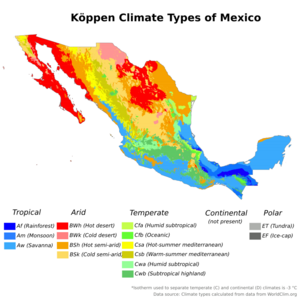
The climate of Mexico is varied due to the country's size and topography. Tropic of Cancer effectively divides the country into temperate and tropical zones. Land north of the Tropic of Cancer experiences cooler temperatures during the winter months. South of the Tropic of Cancer, temperatures are fairly constant year-round and vary solely as a function of elevation. This gives Mexico one of the world's most diverse weather systems. Maritime air masses bring seasonal precipitation from May until August. Many parts of Mexico, particularly the north, have a dry climate with only sporadic rainfall, while parts of the tropical lowlands in the south average more than 2,000 mm (78.7 in) of annual precipitation. For example, many cities in the north like Monterrey, Hermosillo, and Mexicali experience temperatures of 40 °C (104 °F) or more in summer. In the Sonoran Desert temperatures reach 50 °C (122 °F) or more.
There are 7 major climate types in Mexico with warm sub-humid climate being coastal up to 900 meters found mostly in the southern region of Mexico; dry and desertic climates being found in the northern half of the country; temperate humid and sub-humid being found mostly on pastures at an elevation of 1,800 meters and higher in central Mexico and cold climate usually found at an elevation of 3,500 meters and beyond. Most of the country's territory has a temperate to dry climate. Areas south of the Tropic of Cancer with elevations up to 1,000 m (3,281 ft) (the southern parts of both coastal plains as well as the Yucatán Peninsula), have a yearly median temperature between 24 and 28 °C (75.2 and 82.4 °F). Temperatures here remain high throughout the year, with only a 5 °C (9 °F) difference between winter and summer median temperatures. The Pacific coast is subject to natural hazards such as tsunamis and both Mexican coasts with the exception of the south coast of the Bay of Campeche and northern Baja California are vulnerable to serious hurricanes during the summer and fall. Although low-lying areas north of the Tropic of Cancer are hot and humid during the summer, they generally have lower yearly temperature averages (from 20 to 24 °C or 68.0 to 75.2 °F) because of more moderate conditions during the winter.
Biodiversity
Mexico ranks fourth in the world in biodiversity and is one of the 17 megadiverse countries. With over 200,000 different species, Mexico is home of 10–12% of the world's biodiversity. Mexico ranks first in biodiversity in reptiles with 707 known species, second in mammals with 438 species, fourth in amphibians with 290 species, and fourth in flora, with 26,000 different species. Mexico is also considered the second country in the world in ecosystems and fourth in overall species. About 2,500 species are protected by Mexican legislation. In 2002[update], Mexico had the second fastest rate of deforestation in the world, second only to Brazil. It had a 2019 Forest Landscape Integrity Index mean score of 6.82/10, ranking it 63rd globally out of 172 countries. According to SGI there is Deforestation and soil erosion especially in rural areas of Mexico. In the 2022 report it was noted environmental protection laws have improved in major cities but remain unenforced or unregulated in rural regions.

In Mexico, 170,000 square kilometers (65,637 sq mi) are considered "Protected Natural Areas". These include 34 biosphere reserves (unaltered ecosystems), 67 national parks, 4 natural monuments (protected in perpetuity for their aesthetic, scientific or historical value), 26 areas of protected flora and fauna, 4 areas for natural resource protection (conservation of soil, hydrological basins, and forests) and 17 sanctuaries (zones rich in diverse species). Plants indigenous to Mexico are grown in many parts of the world and integrated into their national cuisines. Some of Mexico's native culinary ingredients include maize, tomato, beans, squash, chocolate, vanilla, avocado, guava, chayote, epazote, camote, jícama, nopal, zucchini, tejocote, huitlacoche, sapote, mamey sapote, and a great variety of chiles, such as the habanero and the jalapeño. Most of these names come from the indigenous language of Nahuatl.
Politics
Mexico is a constitutional federal democracy ruled by a president. The president is elected every 6 years.
The president is the head of state and government, as well as the commander-in-chief of the Mexican military forces. The President also appoints the Cabinet and other officers. The President is responsible for executing and enforcing the law and has the power to veto bills.
The federal legislature is the bicameral Congress of the Union, composed of the Senate of the Republic and the Chamber of Deputies. The Congress makes federal law, declares war, imposes taxes, approves the national budget and international treaties, and ratifies diplomatic appointments. The federal Congress, as well as the state legislatures, are elected by a system of parallel voting that includes plurality and proportional representation. The Chamber of Deputies has 500 deputies. Of these, 300 are elected by plurality vote in single-member districts (the federal electoral districts) and 200 are elected by proportional representation with closed party lists for which the country is divided into five electoral constituencies. The Senate comprises 128 senators: 64 (two for each state and two for Mexico City) are elected by plurality vote in pairs, 32 are the first minority or first-runner-up (one for each state and one for Mexico City), and 32 are elected by proportional representation from national closed party lists.
The highest organ of the judicial branch of government is the Supreme Court of Justice, the national supreme court, which has eleven judges appointed by the President and approved by the Senate. The Supreme Court of Justice interprets laws and judges cases of federal competency. Other institutions of the judiciary are the Federal Electoral Tribunal, collegiate, unitary, and district tribunals, and the Council of the Federal Judiciary.
States
|
1. Aguascalientes |
12. Hidalgo |
23. San Luis Potosí |
People
Mexico is the most populous Spanish-speaking country in the world. It is also the second most populous country in Latin America (after Brazil). 60% of Mexicans have Native American and European forefathers; these are called mestizos. Almost 30% of Mexicans are pure Native American and 10% are European. Most Mexicans (90%) speak Spanish. 10% of the Mexicans speak a Native American language, like Nahuatl, the language of the Aztecs, Maya or Zapotec. Most people in Mexico are Roman Catholic (89%) and 6% are Protestant.
Spanish is the de facto national language spoken by the vast majority of the populatio. The federal government officially recognizes sixty-eight linguistic groups and 364 varieties of indigenous languages. It is estimated that around 8.3 million citizens speak these languages, with Nahuatl being the most widely spoken by more than 1.7 million, followed by Yucatec Maya used daily by nearly 850,000 people. English is the most commonly taught foreign language in Mexico.
Economy
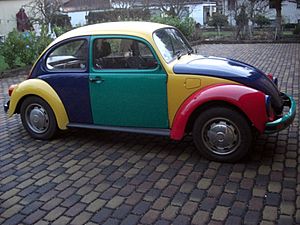
The electronics industry of Mexico has grown enormously within the last decade. Mexico has the sixth largest electronics industry in the world after China, United States, Japan, South Korea, and Taiwan. Mexico is the second largest exporter of electronics to the United States where it exported $71.4 billion worth of electronics in 2011. The Mexican electronics industry is dominated by the manufacture and OEM design of televisions, displays, computers, mobile phones, circuit boards, semiconductors, electronic appliances, communications equipment and LCD modules. The Mexican electronics industry grew 20% between 2010 and 2011, up from its constant growth rate of 17% between 2003 and 2009. Currently electronics represent 30% of Mexico's exports.
Mexico produces the most automobiles of any North American nation. The industry produces technologically complex components and engages in some research and development activities. The "Big Three" (General Motors, Ford and Chrysler) have been operating in Mexico since the 1930s, while Volkswagen and Nissan built their plants in the 1960s. In Puebla alone, 70 industrial part-makers cluster around Volkswagen. In the 2010s expansion of the sector was surging. In 2014 alone, more than $10 billion in investment was committed. In September 2016 Kia motors opened a $1 billion factory in Nuevo León, with Audi also opening an assembling plant in Puebla the same year. BMW, Mercedes-Benz and Nissan currently have plants in construction.
Tourism
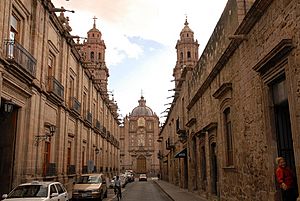
Mexico has traditionally been among the most visited countries in the world according to the World Tourism Organization and it is the most visited country in the Americas after the United States.
The most notable attractions are the Mesoamerican ruins, cultural festivals, colonial cities, nature reserves and the beach resorts. The nation's wide range of climates, from temperate to tropical, and unique culture – a fusion of the European and the Mesoamerican – make Mexico an attractive destination. The peak tourism seasons in the country are during December and the mid-Summer, with brief surges during the week before Easter and Spring break, when many of the beach resort sites become popular destinations for college students from the United States.
Culture
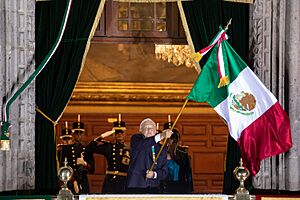
Mexican culture reflects a long and complex history of interactions between various peoples through migration, conquest, and trade. Three centuries of Spanish rule resulted in the blending of Spanish culture with those of different indigenous groups. Efforts to assimilate the native population into Christian European culture during the colonial era were only partially successful, with many pre-Columbian customs, traditions, and norms persisting regionally (particularly in rural areas) or becoming syncretized; conversely, many Spanish settlers integrated into local communities through acculturation or intermarriage. However, a high degree of stratification along the lines of class, ethnicity, and race perpetuated distinct subcultures.
The Porfirian era (el Porfiriato) (1876–1911), which brough relative peace after four decades of civil unrest and war, saw the development of philosophy and art, often with government support. Since that time, as accentuated during the Mexican Revolution, cultural identity has had its foundation in mestizaje: the blending of different races and cultures, of which the indigenous (i.e. Amerindian) element is the core. In light of the various ethnicities that formed the Mexican people, José Vasconcelos in La Raza Cósmica (The Cosmic Race) (1925) defined Mexico and Latin America to be the melting pot of all races (thus extending the definition of the mestizo) not only biologically but culturally as well. Other Mexican intellectuals grappled with the idea of Lo Mexicano, which seeks "to discover the national ethos of Mexican culture." Nobel laureate Octavio Paz explores the notion of a Mexican national character in The Labyrinth of Solitude.
Art
Painting is one of the oldest arts in Mexico. Cave painting in Mexican territory is about 7500 years old and has been found in the caves of the Baja California Peninsula. Pre-Columbian Mexican art is present in buildings and caves, in Aztec codices, in ceramics, in garments, etc.; examples of this are the Maya mural paintings of Bonampak or the murals found in Teotihuacán, Cacaxtla and Monte Albán. Mural painting with Christian religious themes had an important flowering during the 16th century, early colonial era in newly constructed churches and monasteries. Examples can be found in Acolman, Actopan, Huejotzingo, Tecamachalco and Zinacantepec.
As with most art during the early modern era in the West, colonial-era Mexican art was religious during the sixteenth and seventeenth centuries. Starting in the late seventeenth century, and, most prominently in the eighteenth century, secular portraits and images of racial types, so-called casta painting appeared. Important painters of the late colonial period were Juan Correa, Cristóbal de Villalpando and Miguel Cabrera. In early post-independence Mexico, nineteenth-century painting had a marked romantic influence; landscapes and portraits were the greatest expressions of this era. Hermenegildo Bustos is one of the most appreciated painters of the historiography of Mexican art. Other painters include Santiago Rebull, Félix Parra, Eugenio Landesio, and his noted pupil, the landscape artist José María Velasco.

In the 20th century artists such as Diego Rivera, David Alfaro Siqueiros, and José Clemente Orozco, the so-called "Big Three" of Mexican muralism achieved worldwide recognition. They were commissioned by the Mexican government to paint large-scale historical murals on the walls of public buildings, which helped shape popular perceptions of the Mexican Revolution and Mexican cultural identity. Frida Kahlo's largely personal portraiture is considered by many as the most important historical work by a female artist.
In the 21st century, Mexico City became home to the highest concentration of art museums in the world. Institutions like the Museo Jumex, the largest collection of its kind, founded by collector Eugenio López Alonso and bolstered by art advisor Esthella Provas, changed the notion of contemporary art in Latin America. The Museo Tamayo Arte Contemporaneous founded by Rufino Tamayo is also considered a preeminent institution and introduced foreign artists to a wider population. The country is also an epicenter for International art galleries including Kurimanzutto and FF Projects, and leading artists including Gabriel Orozco, Bosco Sodi, Stefan Brüggemann, and Mario García Torres.
Architecture
The architecture of Mesoamerican civilizations evolved in style from simple to complex. Teotihuacan, designated a UNESCO World Heritage Site in 1987, is one of the foremost examples of ancient pyramid construction. The cities of the Maya stand out to modern architects as examples of integration between large urban centers (with elaborate stone construction) and a thick jungle, generally with a complex network of roads. Pre-Columbian Mesoamerica also saw distinctive architectural influences from the Olmec, the Puuc and oasiamerican peoples.

With the arrival of the Spanish, architectural theories of the Greco-Latin order with Arab influences were introduced. In the first few decades of Spanish presence in the continent, the high level of Christian missionary activity, especially by mendicant orders like the Dominicans or Franciscans, meant the construction of many monasteries, often with Romanesque, Gothic or Mudéjar elements. In addition, the interaction between Spaniards and Indigenous people gave rise to artistic styles such as the tequitqui (from the Nahuatl: worker or builder). Years later, Baroque and Mannerist styles prevailed in large cathedrals and civil buildings, while in rural areas, haciendas or stately estates with Mozarabic tendencies were built. In the 19th century, the neoclassical movement arose as the country gained independence and sought to establish itself as a republic. A famous example is the Hospicio Cabañas, an orphanage and hospital complex completed in 1829. The art nouveau, and the art deco were styles introduced into the design of the Palacio de Bellas Artes to mark the identity of the Mexican nation with Greek-Roman and pre-Columbian symbols.
As a new sense of nationalism developed in the 20th century, a strengthened central government issued formal policies that sought to use architecture to show Mexico's modernity and differentiation from other nations. The development of Mexican modernist architecture was especially manifested in the mid-1950s construction of the Ciudad Universitaria, Mexico City, the main campus of the National Autonomous University of Mexico. Designed by the most prestigious architects of the era, including Mario Pani, Eugenio Peschard, and Enrique del Moral, the buildings feature murals by artists Diego Rivera, David Alfaro Siqueiros, and José Chávez Morado. It has since been recognized as a UNESCO World Heritage Site.
Juan O'Gorman was one of the first environmental architects in modern Mexico to develop the "organic" theory, trying to integrate buildings onto the landscape within the same approaches of Frank Lloyd Wright. In the search for a new architecture that does not resemble the styles of the past, it achieves a joint manifestation with the mural painting and the landscaping. Luis Barragán combined the shape of the space with forms of rural vernacular architecture of Mexico and Mediterranean countries (Spain-Morocco), integrating color that handles light and shade in different tones and opens a look at the international minimalism. He won the 1980 Pritzker Prize, the highest award in architecture.
Cuisine

The origin of the current Mexican cuisine was established during the Spanish colonial era, a mixture of the foods of Spain with native indigenous ingredients. Foods indigenous to Mexico include corn, pepper vegetables, calabazas, avocados, sweet potato, turkey, many beans, and other fruits and spices. Similarly, some cooking techniques used today are inherited from pre-Columbian peoples, such as the nixtamalization of corn, the cooking of food in ovens at ground level, grinding in molcajete and metate. With the Spaniards came the pork, beef and chicken meats; peppercorn, sugar, milk and all its derivatives, wheat and rice, citrus fruits and another constellation of ingredients that are part of the daily diet of Mexicans.
From this meeting of two millennia old culinary traditions, were born pozole, mole sauce, barbacoa and tamale in its current forms, chocolate, a large range of breads, tacos, and the broad repertoire of Mexican street foods. Beverages such as atole, champurrado, milk chocolate and aguas frescas were born; desserts such as acitrón and the full range of crystallized sweets, rompope, cajeta, jericaya and the wide repertoire of delights created in the convents of nuns in all parts of the country.
In 2005, Mexico presented the candidature of its gastronomy for World Heritage Site of UNESCO, the first time a country had presented its gastronomic tradition for this purpose. The result was negative, because the committee did not place the proper emphasis on the importance of corn in Mexican cuisine. On 16 November 2010 Mexican gastronomy was recognized as Intangible cultural heritage by UNESCO. In addition, Daniela Soto-Innes was named the best female chef in the world by The World's Best 50 Restaurants in April 2019 and Elena Reygadas in 2023.
Literature
Mexican literature has its antecedents in the literature of the indigenous settlements of Mesoamerica. Poetry had a rich cultural tradition in pre-Columbian Mexico, being divided into two broad categories—secular and religious. Aztec poetry was sung, chanted, or spoken, often to the accompaniment of a drum or a harp. While Tenochtitlan was the political capital, Texcoco was the cultural center; the Texcocan language was considered the most melodious and refined. The best well-known pre-Columbian poet is Nezahualcoyotl.
There are historical chronicles of the conquest of the Aztec Empire by participants, and, later, by historians. Bernal Díaz del Castillo's True History of the Conquest of the New Spain is still widely read today. Spanish-born poet Bernardo de Balbuena extolled the virtues of Mexico in Grandeza mexicana (Mexican Grandeur) (1604). Baroque literature flourished in the 17th century; the most notable writers of this period were Juan Ruiz de Alarcón and Juana Inés de la Cruz. Sor Juana was famous in her own time, called the "Ten Muse".
Nineteenth-century liberal of Nahua origin Ignacio Manuel Altamirano is an important writer of the era, along with Vicente Riva Palacio, the grandson of Mexican hero of independence Vicente Guerrero, who authored a series of historical novels as well as poetry, the late colonial-era novel by José Joaquín Fernández de Lizardi, The Mangy Parrot ("El Periquillo Sarniento"), is said to be the first Latin American novel. In the modern era, the novel of the Mexican Revolution by Mariano Azuela (Los de abajo, translated to English as The Underdogs) is noteworthy. Poet and Nobel Laureate Octavio Paz, novelist Carlos Fuentes, Alfonso Reyes, Renato Leduc, essayist Carlos Monsiváis, journalist and public intellectual Elena Poniatowska, and Juan Rulfo (Pedro Páramo), Martín Luis Guzmán, Nellie Campobello, (Cartucho).
Cinema
Mexican films from the Golden Age in the 1940s and 1950s are the greatest examples of Latin American cinema, with a huge industry comparable to the Hollywood of those years. Mexican films were exported and exhibited in all of Latin America and Europe. María Candelaria (1943) by Emilio Fernández, was one of the first films awarded a Palme d'Or at the Cannes Film Festival in 1946, the first time the event was held after World War II. The famous Spanish-born director Luis Buñuel realized in Mexico between 1947 and 1965 some of his masterpieces like Los Olvidados (1949) and Viridiana (1961). Famous actors and actresses from this period include María Félix, Pedro Infante, Dolores del Río, Jorge Negrete and the comedian Cantinflas.
More recently, films such as Como agua para chocolate (1992), Sex, Shame, and Tears (1999), Y tu mamá también (2001), and The Crime of Father Amaro (2002) have been successful in creating universal stories about contemporary subjects, and were internationally recognized. Mexican directors Alejandro González Iñárritu (Babel, Birdman, The Revenant, Bardo, False Chronicle of a Handful of Truths), Alfonso Cuarón (A Little Princess, Harry Potter and the Prisoner of Azkaban, Gravity, Roma), Guillermo del Toro (Pan's Labyrinth, Crimson Peak, The Shape of Water, Nightmare Alley), screenwriter Guillermo Arriaga and photographer Emmanuel Lubezki are some of the most known present-day film makers.
Music and dance
Mexico has a long tradition of music from the prehispanic era to the present. Much of the music from the colonial era was composed for religious purposes.
Although the traditions of European opera and especially Italian opera had initially dominated the Mexican music conservatories and strongly influenced native opera composers (in both style and subject matter), elements of Mexican nationalism had already appeared by the latter part of the 19th century with operas such as Aniceto Ortega del Villar's 1871 Guatimotzin, a romanticized account of the defense of Mexico by its last Aztec ruler, Cuauhtémoc. The most well-known Mexican composer of the twentieth century is Carlos Chávez (1899–1978), who composed six symphonies with indigenous themes, and rejuvenated Mexican music, founding the Orquesta Sinfónica Nacional.
Traditional Mexican music includes mariachi, banda, norteño, ranchera, and corridos. Corridos were particularly popular during the Mexican Revolution (1910–20) and in the present era include narcocorridos. The embrace of rock and roll by young Mexicans in the 1960s and 1970s brought Mexico into the transnational, counterculture movement of the era. In Mexico, the native rock culture merged into the larger countercultural and political movement of the late 1960s, culminating in the 1968 protests and redirected into counterculture rebellion, La Onda (the wave).
On an everyday basis most Mexicans listen to contemporary music such as pop, rock, and others in both English and Spanish. Folk dance of Mexico along with its music is both deeply regional and traditional. Founded in 1952, the Ballet Folklórico de México performs music and dance of the prehispanic period through the Mexican Revolution in regional attire in the Palacio de Bellas Artes.
Sports

Organized sport in Mexico largely dates from the late nineteenth century, with only bullfighting having a long history dating to the early colonial era. Once the political turmoil of the early republic was replaced by the stability of the Porfiriato did organized sport become public diversions, with structured and ordered play governed by rules and authorities. Baseball was introduced from the United States and also via Cuba in the 1880s and organized teams were created. Mexico's most popular sport is association football.
The bid to host the 1968 Summer Olympics was to burnish Mexico's stature internationally, with it being the first Latin American country to host the games. The government spent abundantly on sporting facilities and other infrastructure to make the games a success, but those expenditures helped fuel public discontent with the government's lack of spending on social programs. Mexico City hosted the XIX Olympic Games in 1968, making it the first Latin American city to do so. Mexico hosted the 1970 FIFA World Cup and the 1986 FIFA World Cup and will co-host, along with Canada and the United States, the 2026 FIFA World Cup. With its past hosting of the 1970 and 1986 tournaments, Mexico will become the first country to host or co-host the men's World Cup three times.
Mexico is an international power in professional boxing. Fourteen Olympic boxing medals have been won by Mexico. The Mexican professional baseball league is named the Liga Mexicana de Beisbol. While usually not as strong as the United States, the Caribbean countries and Japan, Mexico has nonetheless achieved several international baseball titles. Lucha Libre (freestyle professional wrestling) is also major crowd draw with national promotions such as AAA, CMLL and others.
Despite efforts by animal rights activists to outlaw bullfighting, it remains a popular sport in the country, and almost all large cities have bullrings. Plaza México in Mexico City, which seats 45,000 people, is the largest bullring in the world.
Related pages
Images for kids
-
View of the Pyramid of the Sun in the ancient city-state of Teotihuacan, which was the 6th largest city in the world at its peak (1 AD to 500 AD)
-
Mural by Diego Rivera depicting a view from the Tlatelolco markets into Mexico-Tenochtitlan, the largest city in the Americas at the time.
-
View of the Plaza Mayor (today Zócalo) in Mexico City (ca. 1695) by Cristóbal de Villalpando
-
Luis de Mena, Virgin of Guadalupe and castas, showing race mixture and hierarchy as well as fruits of the realm, ca. 1750
-
General Antonio López de Santa Anna
-
Portrait of Liberal President Benito Juárez
-
The Execution of Emperor Maximilian, 19 June 1867. Gen. Tomás Mejía, left, Maximiian, center, Gen. Miguel Miramón, right. Painting by Édouard Manet 1868.
-
Francisco I. Madero, who challenged Díaz in the fraudulent 1910 election and was elected president when Díaz was forced to resign in May 1911.
-
Revolutionary Generals Pancho Villa (left) and Emiliano Zapata (right)
-
NAFTA signing ceremony, October 1992. From left to right: (standing) President Carlos Salinas de Gortari (Mexico), President George H. W. Bush (U.S.), and Prime Minister Brian Mulroney (Canada)
-
Vicente Fox and his opposition National Action Party won the 2000 general election, ending one-party rule.
-
Mexico City, the financial center of Mexico
-
The Central Eólica Sureste I, Fase II in Oaxaca.
-
Large Millimeter Telescope in Puebla.
-
Cancún and the Riviera Maya is the most visited region in Latin America
-
The Baluarte Bridge was the highest cable-stayed bridge in the world, the fifth-highest bridge overall and is the highest bridge in the Americas.
-
Las castas. Casta painting showing 16 racial groupings, 18th century, Museo Nacional del Virreinato, Tepotzotlán, Mexico.
-
Mexico–United States barrier between San Diego's border patrol offices in California, USA (left) and Tijuana, Mexico (right)
-
Central Library of the National Autonomous University of Mexico
-
Octavio Paz, the only mexican awarded with the Nobel Prize in Literature
-
Mexican composer Carlos Chávez
-
Televisa headquarters in Mexico City
See also
 In Spanish: México para niños
In Spanish: México para niños





